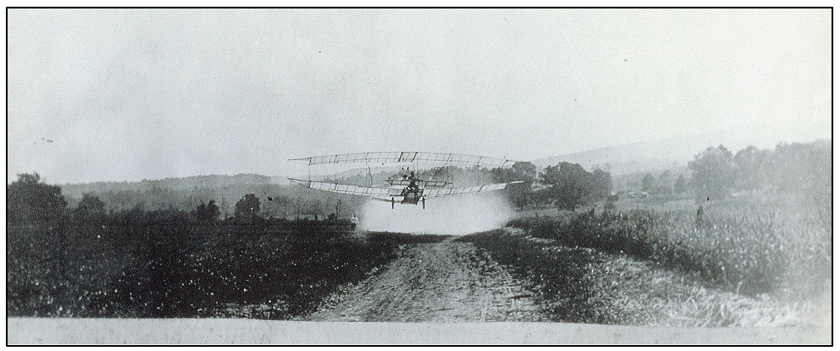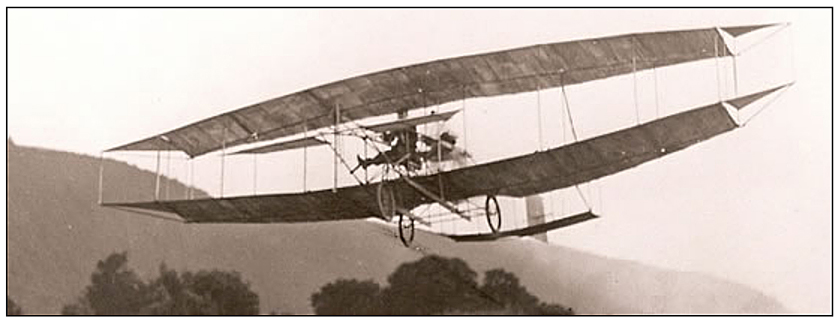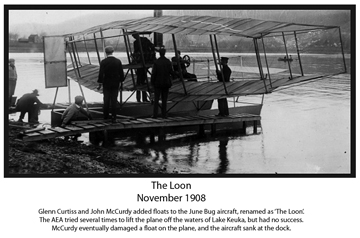The June Bug - Aerodrome 3
The Aerial Experiment Association realized that the issue of lateral stability had been greatly enhanced with the use of ailerons on the White Wing. Following the crash and break up of Aerodrome 2, they determined to make additional modifications and strengthen their next aircraft.
Aerodrome 3, therefore, included a new feature at the front of the craft: a moveable 'canard' or elevator in front design that improved the handling of the aerodrome in flight by allowing the pilot to control the elevation by making subtle up and down adjustments to the canard. This canard, coupled with the ailerons, would make the June Bug the most stable of their aircraft thus far.

The June Bug received it's name from the yellow ochre added to the the shellac and varnish combination that was painted on the porous white cloth covering of the wings. It was the first airplane to have its wings doped to provide a surface covering that would provide more lift to the aircraft. On June 14, 1908, Dr. Bell, upon seeing the aerodrome in its yellow painted finish remarked that the craft reminded him of a June Bug. 1
The June Bug's maiden flight was taken on June 21st and covered a mere 152 yards in eleven seconds. By June 27th, on its seventh flight with Glenn Curtiss at the controls, the June Bug flew for sixty seconds and covered a distance of 1140 yards. 2
Earlier progress encouraged the AEA members to contact Dr. Bell, who had returned to Washington, about having the June Bug compete for the Scientific American Trophy. Based upon their success and confidence Bell agreed.
The AEA contacted the Scientific American and officials of the Aero Club of America to make arrangements to do a public demonstration flight of one kilometre's length in Hammondsport.
On July 4, 1908 the entourage of officials from the Aero Club, Scientific American and the press assembled around a field on Stoney Brook Farm just west of the village of Hammondsport. Contemporary reports indicate that almost all the residents of the village were on hand to see Curtiss make the attempt at the one kilometre measured flight in full view of the officials.
Excitement and anxiety were running neck and neck as the day wore on and the AEA members tinkered with the June Bug. On the first attempt the June Bug only flew a distance of 900 yards in 56.5 seconds. Curtiss was having trouble controlling the aerodrome and decided to bring it down at the 900 yard mark.
The AEA boys examined the June Bug and found that the adjustable tail was not properly configured. After adjusting the tail a second trial was scheduled for five o'clock in the afternoon.
With photographers, officials and a huge crowd of spectators in place the June Bug's engine roared to life as the propellor was spun. Curtiss taxied the aerodrome onto the dirt hors track that served as a runway and gunned the engine. The aerodrome lifted and officials carefully marked the point where the wheels left the ground.
Flying along at an altitude of some twenty to thirty feet Curtiss kept the June Bug aloft for a distance of 2000 yards in a flight that lasted 102.5 seconds. As he was running out of space for straight line flying, Curtiss brought the June Bug carefully down in a corn field just short of a copse of trees. 3

The crowd went wild as the plane landed well past the measured one kilometre distance required to win the Scientific American Trophy. The AEA had in a span of seven short months mastered the rudiments of aviation and surpassed the Wright Brothers who had been first to fly on Dec. 13, 1903. "Bell's Boys", as the group had been named by the press, were leading North American aviation and in the vanguard of flight pioneers around the world.
The June Bug went on to make many more flights and provided flight experience to Douglas McCurdy and Casey Baldwin of the AEA as well.
As the AEA moved on to construction of their next project, the Silver Dart, they contemplated the possibility of flying their aerodromes off the surface of water. The June Bug was fitted with a set of floats making it one of the very first aircraft in the world to be configured for attempted seaplane flying. 4
 Nicknamed 'The Loon' in its flotation undergear configuration, the June Bug was only successful at taxiing on the waters of Lake Keuka in Hammondsport. However, even these fledgling experiments provided pioneering knowledge of how to accomplish flight from the surface of the water that would later be mastered by Glenn Curtiss in 1909.
Nicknamed 'The Loon' in its flotation undergear configuration, the June Bug was only successful at taxiing on the waters of Lake Keuka in Hammondsport. However, even these fledgling experiments provided pioneering knowledge of how to accomplish flight from the surface of the water that would later be mastered by Glenn Curtiss in 1909.
______
Notes:
- Image of 'June Bug rising above the race track runway at Pleasant Valley Farm' and 'June Bug in Flight with Curtiss at controls' are dated July 4, 1908 and are part of the document collection at both the Glenn H. Curtiss Museum in Hammondsport, NY and the A.G. Bell National Historic Site in Baddeck, NS. Appreciation is extended to both sites for permission to publish.
- Glenn Curtiss: Pioneer of Flight. C.R. Roseberry, Doubleday and Company, New York, 1972. Page 104-5.
- Records of Flights of the AEA Aerodrome #3 (June Bug). AEA document located at the Glenn H. Curtiss Museum, Hammondsport NY.
- Curtiss' "June Bug" wins Flight Contest. Scientific American, July 1908 edition. A reprint is on-line as part of the Scientific American July 2008 feature: '100 Years Ago in Scientific American'.
- Photograph of 'Loon' (June Bug on floats) courtesy of the Glenn H. Curtiss Museum, Hammondsport, NY.




